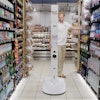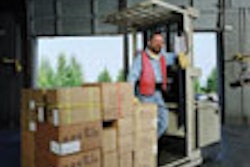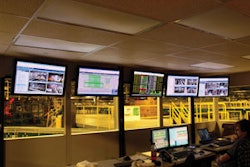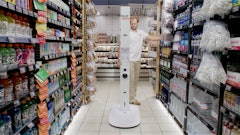
People. Process. Performance. These are the three elements behind the success of The Hershey Co.
Hershey is the largest producer of quality chocolate in North America and a global leader in chocolate and sugar confectionery. Headquartered in Hershey, PA, the company has operations throughout the world and more than 12,000 employees.
With revenues of more than $5 billion, Hershey offers such iconic brands as Hershey’s, Reese’s, Hershey’s Kisses, Kit Kat, Twizzlers, Ice Breakers and Hershey’s Bliss. Hershey is a leader in the fast-growing dark and premium chocolate segment, with such brands as Hershey’s Special Dark and Hershey’s Extra Dark. In addition, Artisan Confections Co., a wholly owned subsidiary of Hershey, markets such premium chocolate offerings as Scharffen Berger, Dagoba and Starbucks Chocolate.
In 2007, the candy maker embarked on a three-year Global Supply Chain Transformation (GSCT) program to enhance its manufacturing, sourcing and customer service capabilities. The transformation program is resulting in a flexible, global supply chain capable of delivering Hershey’s brands in a wide range of items and assortments, across the retail channels in the company’s priority markets.
Hershey’s Eastern Distribution Center III, or EDC III, is contributing to the success of the GSCT program. The facility consistently delivers productivity goals averaging above 100 percent—thanks to the extraordinary efforts of the company’s 610 full-time associates that work there. It also boasts an inventory accuracy rate of 99.9 percent.
You won’t find a lot of automation in this facility, but what you will find is a strong commitment to superior customer service, a great working relationship between Hershey and Exel, its third-party logistics provider and—most importantly—a hardworking group of dedicated associates.
For these reasons, the EDC III has received Food Logistics’ Golden Pallet award in the manufacturer category.
The Golden Pallet Awards, sponsored by Food Logistics, are the first industry awards to recognize excellence in warehousing. Three more Golden Pallet award winners will be profiled in upcoming issues of FL.
The EDC III is located close to Hershey’s five manufacturing plants in Pennsylvania. The 1.2 million-square-foot-facility was built in 1999 to accommodate growth in the Hershey’ network. While the building is owned by Hershey, the facility is operated by Westerville, OH-based Exel.
This is the largest of the company’s five distribution centers in North America and has the highest throughput. The EDC III serves other Hershey distribution centers as well as more than 1,600 retail locations.
The facility is divided into two areas—the distribution operation and a 167,000-square-foot co-pack area, where product is converted into merchandising and promotional displays. There are also two identical pick tunnels for case handling. While both operations are overseen by the general manager, each is staffed separately.
“The dedication and motivation of the associates who work here is exceptional,” says Wil Richardson, Exel’s general manager. “The facility boasts an attendance record and an annual turnover rate that exceeds industry standards. Based on internal employee satisfaction surveys, the EDC III associates indicate that they are ‘very satisfied’ with their jobs, which translates into a higher quality performance and a direct linkage to profitability and reduced costs.”
Hershey’s and Exel’s management teams have worked very closely with the associates to achieve these results. The team has implemented the Performance Management Process (PMP) program, which is a structured approach to planning, execution, follow-up and reporting of site activities. It facilitates two-way communication between associates and managers and provides consistent alignment of business and associate objectives, while allowing for further development of the workforce.
For example, every six weeks the company has roundtable meetings with 10 to 12 employees from each shift from both the DC and co-pack operations. “We discuss anything they want to talk about,” says Richardson. “We’re looking for their feedback as to how things are going as well as suggestions for improvement. After the meetings, we post all of the questions with the answers. We do this in four languages as we are a multi-cultural organization and many of our associates are not fluent in English.”
“It’s very impressive to see the range of questions and the extent to which Exel goes to answer each and every one of those questions,” says Jim Grap, Hershey’s director of distribution and transportation.
Richardson adds, “There have been many suggestions that have come out of the process that we’ve implemented, so our associates know that their ideas are taken seriously. That goes a long way in building morale.”
Another program is Quick Change Improvement (QCI), in which associates submit ideas for operational improvement. “Many of the improvements in the facility are the result of these ideas,” says Richardson. “If an idea is implemented, we recognize the associate at his or her shift meeting.”
One idea that came from a QCI was to hang small yellow buoys with chains from the ceiling to indicate safe travel lanes for material handling equipment, as opposed to painting lines on the floor, which wear off over time. Plus, it’s easier for operators to see the yellow buoys.
Exel uses a labor management process that uses engineered standards and a self-funding incentive program to drive increased productivity—resulting in the need for fewer employees.
“This is a very mature site as far as the use of engineered standards,” says Exel’s Ron Murphy, senior director of operations for the consumer business unit. “We’ve managed these standards since 2002 and have some very effective employee incentives for our associates. They have an opportunity to make extra money through their own individual performance.”
Murphy adds that hourly associates who are not measured through engineered standards, such as maintenance, clerical or sanitation workers, can earn compensation from the incentive plan based on team performance. While the incentives go a long way in helping to retain employees, opportunities for career growth and professional development keep high-performers from seeking work elsewhere.
“We promote from within all the time,” says Richardson. “Between the distribution and co-pack operations, we have a total of 23 production or operation supervisors. Of those 23, 10 originally joined the company as hourly employees.”
Other morale boosters include holiday celebrations for the associates and their families. At Christmas time, there’s a party with Santa and gifts for the children and an egg hunt at Easter. Every June, Exel holds a picnic at a local park and management does all of the cooking.
In addition, the company periodically serves up pizza and ice cream on all shifts. “It’s all about employee satisfaction,” says Richardson.
TECHNOLOGY RULES
The employees keep the operation running smoothly, but at the heart of the EDC III is a powerful warehouse management system (WMS) from RedPrairie Corp., headquartered in Milwaukee. From the moment a product enters the site through the time it leaves, it is tracked electronically—no paper is used.
This has significantly reduced costs and increased productivity. For example, the WMS has replaced the need for a warehouse driver to physically walk to the warehouse office to submit and check paperwork, which saves approximately 173 days (five minutes per load x 50,000 loads a year) of inefficiency.
“This idea was actually a joint effort between Hershey and Exel and the associates,” says Richardson. “An associate pointed out how much time they were wasting, waiting for the paperwork at the office between loading and unloading the trucks. We modified the WMS so that they get the information right on their equipment-mounted terminal and they’re able to pick more freight and earn more money.”
RF technology, which is tied into the WMS, is also saving the site the equivalent of two annual full-time associates through a lift truck battery pit stop process leveraging real-time access to email.
“When an operator needs a battery change, an email is sent to the battery room to get a new battery ready,” says Vince Koleck, Hershey’s distribution operations manager. “The person in the battery changing room controls the flow and they always have a battery ready, so there’s never a waiting line. We’ve conservatively estimated that it saves five minutes for every battery changed, which works out to about 350 to 400 hours per month.”
The WMS is also tied into the company’s welcome center, an area outside the building where the trucks enter. “The drivers don’t have to get out of their cabs,” says Koleck. “Everything is handled electronically. Their trailers are loaded, pre-staged for the most part, and they can be in and out of this facility in less than an hour.”
The yard service is also tied into the WMS. All of the trailers are tracked via RF, and the yard jockeys know where the trailers are at all times.
Hershey’s carriers use an online service called Automated Carrier Equipment Status Report, which was developed by Exel. The service allows the carriers to check the status of any trailer at any time through a website, so they can dispatch their drivers as they are needed. The carriers can also get a status report via email.
BUILDING BASICS
Throughout the EDC III, the temperature is kept at 55 degrees to maintain product integrity. The docks are also maintained at 55 to 60 degrees—as are the trucks used to ship and receive the product. The building features 46-foot high ceilings and is racked seven high, double deep. There are 188,000 pallet positions and 163 dock doors.
One of the unique aspects of the EDC III is the co-pack operation, where product is converted into merchandising and promotional displays. Candy is transferred from intermediate shipping cases and re-boxed into promotional packaging. Unlike many manufacturers that ship product to a co-packer and then back for distribution, Hershey handles the entire operation under one roof, saving on freight costs and increasing response time.
“While warehousing and co-packing are separate operations, the interactions between them are very seamless to Hershey,” says Kurt Lowther, Hershey’s account manager, global manufacturing alliances. “If we get an order in today and we don’t have it in stock, we can produce it by tomorrow morning. It allows us to be very responsive and maintain an annual case fill rate for this facility at 98.5 percent.”
In addition, the EDC III can fill orders for other distribution centers throughout the Hershey network.
Another unique aspect of the EDC III is the pick tunnels, where the company handles less than full pallet cases. “Case pick productivity is one of our success stories,” says Richardson. “Case picking was one of the least desirable functions, but our associates were given the opportunity to be dedicated case pickers and make more money. Physically, it’s the toughest job but if you’re willing to do that, you can make out pretty well from the incentive plan standpoint.”
Richardson points out that engineered standards started in 2002 and every year since case productivity has gone up. “In 2002 we averaged 227 cases per hour and in 2008 the average number was 388 cases per hour. Over the six years, productivity has gone up about 71 percent,” he says.
The EDC III also serves as a test facility, where new concepts are tested and, if successful, rolled out to other DCs.
Looking to the future, Hershey is considering centralizing its co-packing operation at the EDC III. “We have several co-packing operations throughout the U.S. and we’re figuring out how to combine more into this facility. We’re looking into different technologies, such as robotics,” says Grap. “We rely heavily on Exel to come up with new ideas that would benefit the operation.”
And, of course, Hershey will continue to rely on the hard work and determination of its valued associates.
“Together, the people and the processes add up to performance for the Hershey Co.,” says Richardson.
EDC III AT A GLANCE
Location: Palmyra, PA
Facility size: 1,285,000 square feet
Employees: 610, up to 900 at peak season
Locations served: 1,617
SKUs: 2,200
Dock doors: 163

















